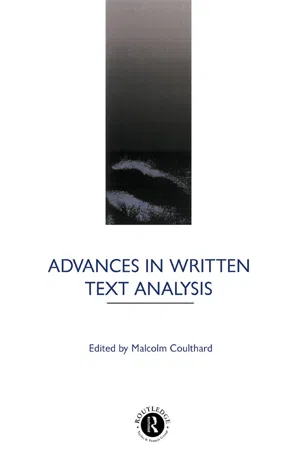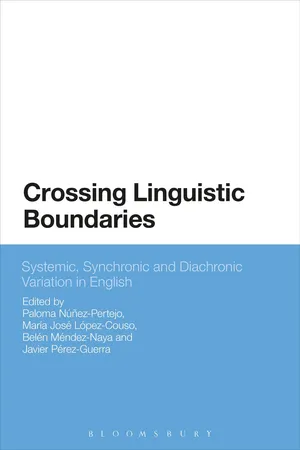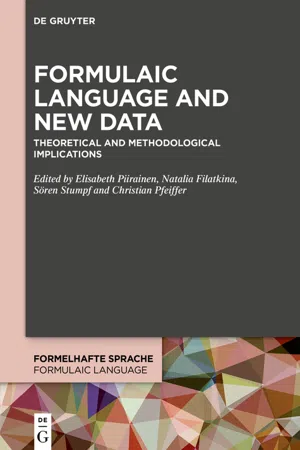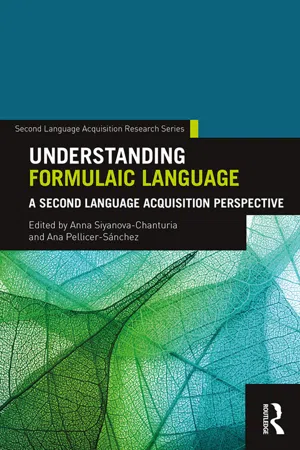Fixed Expressions
Fixed expressions are phrases or idioms that have a set structure and meaning that cannot be changed. They are often used in everyday language and are not typically altered or modified. Examples of fixed expressions include "kick the bucket" and "piece of cake." These expressions are important in understanding the nuances of a language and its cultural context.
5 Key excerpts on "Fixed Expressions"
- eBook - ePub
- Malcolm Coulthard, Malcolm Coulthard(Authors)
- 2002(Publication Date)
- Routledge(Publisher)
...8 The analysis of Fixed Expressions in text Rosamund Moon In general, studies of Fixed Expressions—idioms, formulae such as proverbs and catchphrases, and anomalous or ill-formed collocations—concentrate on their typological and syntagmatic properties. Attention is given to such things as the degree of their lexical and syntactic frozenness, or their transformation potential; and even the primary characteristic of idioms, their non-compositionality as lexical units, may be seen as a matter of the interpretation of a syntagm. However, it is their paradigmatic properties which are of importance in relation to interaction. Fixed Expressions represent meaningful choices on the part of the speaker/writer. They are single choices (see Sinclair 1987b: 321 and passim), and, as with other kinds of lexical item, their precise values and force should be considered in terms of the paradigm operating at each slot or choice. By taking into account paradigmatic as well as syntagmatic aspects, it is possible to assess the way in which Fixed Expressions contribute to the content, structure and development of a text. Fixed Expressions, especially highly colourful and metaphorical idioms and proverbs, are comparatively infrequent. They appear to be more frequent in spoken text than written, although to date there are few extensive studies of their actual distribution. Strässler assesses the frequency of idioms, excluding phrasal verbs, in spoken discourse as around one per 4.5 minutes of conversation (1982:81)...
- eBook - ePub
Crossing Linguistic Boundaries
Systemic, Synchronic and Diachronic Variation in English
- Paloma Núñez-Pertejo, María José López-Couso, Belén Méndez-Naya, Javier Pérez-Guerra, Paloma Núñez-Pertejo, María José López-Couso, Belén Méndez-Naya, Javier Pérez-Guerra(Authors)
- 2019(Publication Date)
- Bloomsbury Academic(Publisher)
...The lower end of this cline is represented by collocations as indicated in the previous section. Thus, two words like pointless exercise have a high probability of co-occurrence, but other combinations can, and do, occur, e.g., futile exercise. At the high end of the inflexibility cline are sequences which are non-compositional and allow for no variation, e.g., Tom, Dick and Harry, so that a sequence like Tom, Michael and Harry is not a semantic equivalent to the first one. The issue of inflexibility is not of concern in the present chapter. Here the focus is on the prosodic structure of Fixed Expressions. Whether all such structures are classified as idioms is a matter of linguistic stance. For instance, binomials, commonly occurring sequences of two elements linked by a conjunction, e.g., fun and games, give and take, flesh and blood, share with conventional idioms, like kick the bucket, that the elements they consist of do not allow of variation. Thus, sequences like entertainment and games, handing over and take, meat and blood are not semantic equivalents to the forms given above. It is the lack of variation in the internal structure of expressions which renders them ‘fixed’ and this fixedness is connected, in the view of the present author, to specific prosodic patterns. For this reason, the term ‘ fixed expression’, rather than ‘idiom’, will be used in the remainder of this article. 2. Prosody in English As a stressed-timed language, English can exploit stress contrasts for semantic purposes, as can be seen with many verb-noun pairs, all of French origin, e.g., ’ record (noun) # re ’ cord (verb), ’ convert (noun) # con ’ vert (verb). The option of having two consecutive syllables with approximately the same degree of stress yields the pattern of equal stress, which can then contrast with initial stress, cf...
- eBook - ePub
Formulaic Language and New Data
Theoretical and Methodological Implications
- Elisabeth Piirainen, Natalia Filatkina, Sören Stumpf, Christian Pfeiffer, Elisabeth Piirainen, Natalia Filatkina, Sören Stumpf, Christian Pfeiffer(Authors)
- 2020(Publication Date)
- De Gruyter(Publisher)
...Selected Polish expressions belonging to this group will be analyzed in the analytical part of the paper (2). Fernando (1996) draws attention to the fact that pragmatic idioms differ significantly from ideational ones, which is important from the research perspective. First of all, pragmatic idioms are “overtly or covertly marked for interaction” (Fernando 1996: 154). Being discourse-oriented, they contribute greatly to structuring the conversation and ensuring its coherence. To a great extent, the realization of stereotyped speech acts relies on conventional phrases (Kauffer 2013). In fact, although some of the expressions in question are fixed and lexically invariant, like After you or Say when, others are embedded in variant forms. Happy birthday is an example of this latter group: it can appear on its own as well as in variants, for instance, Have a happy birthday, Have a very happy birthday, Wishing you a very happy birthday etc. (Fernando 1996: 154). Adopting the function as the main criterion, Granger and Paquot (2008) propose an extended version of Burger’s classification of Fixed Expressions (2010: 36-42), which is adopted for the purpose of the present study. They distinguish three main groups of phrasemes: referential, textual (extending Burger’s structural phraseme category), and communicative. Referential phrasemes are carriers of content messages, i.e. they refer to persons, objects, phenomena etc. According to Granger and Paquot (2008: 42), this group comprises the following kinds of units: lexical and grammatical collocations, idioms, irreversible bi- and trinomials, similes, compounds, and phrasal verbs. Textual phrasemes include: complex prepositions, complex conjunctions, linking adverbials, and textual sentence stems...
- eBook - ePub
Idioms
Description, Comprehension, Acquisition, and Pedagogy
- Dilin Liu(Author)
- 2017(Publication Date)
- Routledge(Publisher)
...For example, Biber et al. (1999, p. 1024), in their comprehensive English grammar book, define idioms as “expressions with a meaning not entirely derivable from the meaning of their parts.” Similarly, the Cambridge dictionary of American idioms (2003), for example, defines idioms as follows: “An idiom is a phrase whose meaning is different from the meanings of each word considered separately. These phrases have a fixed form—they usually cannot be changed” (p. ix). ESL idiom publications often place a special emphasis on the invariance of structure as the most important feature of idioms. For instance, McMordie (1972), in the book English Idioms, states emphatically, “As a general rule an idiomatic phrase cannot be altered; no other synonymous word can be substituted for any word in the phrase, and the arrangement of the words can rarely be modified” (p. 6). This invariance feature presupposes that idioms are multiword expressions. Cowie and Mackin (1975) make the point very clear in their Oxford dictionary of current idiomatic English, for they begin their idiom definition by saying, “an idiom is a combination of two or more words which function as a unit of meaning” (p. ix). The reason for excluding single words as idioms for L2 learners is rather simple and obvious: no matter how difficult it is, a single word is just an individual vocabulary item, and to learn it is basically the same as to grasp any other regular individual word. Learning idioms, on the other hand, is a different matter as it involves the challenge of not only figuring out their unique meanings but also dealing with their invariance or restricted variance in form. In short, for L2 learners, idioms are perhaps best defined as multiword expressions that are invariant or variance-restricted in structure and often (not always) non- or semi-literal in meaning...
- eBook - ePub
Understanding Formulaic Language
A Second Language Acquisition Perspective
- Anna Siyanova-Chanturia, Ana Pellicer-Sánchez, Anna Siyanova-Chanturia, Ana Pellicer-Sánchez(Authors)
- 2018(Publication Date)
- Routledge(Publisher)
...The former, conventions of language, are what make up the language, at least in part. The latter, conventions of usage, are a matter of culture (manners, religion, law…). (Morgan, 1978, p. 269) To demonstrate the difference between the two types of conventions, let us look at the following examples: (2) Renting a car Clerk: Can I help you, sir. Customer: Yes, I have a reservation. Clerk: Your name, please. Customer: James Cunning. Clerk: May I see your driver’s license, Mr. Cunning? None of the expressions used by the interlocutors look freely generated. Each of them can be considered a formula. However, if we consider the following conversation, we may see something different. (3) Bill and David are talking. Bill: If we want to be on time we will need to take a taxi. David: OK, my friend. Can the expressions in bold be considered formulas? Are they in any way different from the ones in example (2)? There is no doubt that the expressions in bold consist of words that are frequently used together. But are they formulas here? Do they have some kind of psychological saliency as formulas for the speakers? We must be careful with the answer because frequency of occurrence of word sequences is only one of the criteria based on which we can identify formulaic expressions. The problem is that the role of frequency seems to be overemphasized in present-day linguistics, especially in corpus linguistics. Recent research analyzing written and spoken discourse has established that highly frequent, recurrent sequences of words, variously called lexical bundles, chunks, and multiword expressions, are not only salient but also functionally significant (e.g., Biber et al., 1999; Ellis et al., 2008). Cognitive research demonstrated that knowledge of these ready-made expressions is crucial for fluent processing. The recurrent nature of these units is discussed in the relevant literature (Biber et al., 1999; McEnery & Wilson, 1996)...




